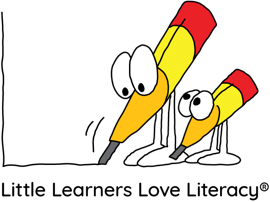Newsletter
A short sentence describing what someone will receive by subscribing
Newsletter
New South Wales Curriculum 2023 - Phonic Knowledge
The New South Wales curriculum outcomes align very well with the Little Learners Love Literacy® explicit scope and sequence. Here's an overview of the Phonic Knowledge outcomes alignment at Early Stage 1:

Earlier this year the Little Learners team created an additional Teacher Activity Resource for schools in New South Wales. This additional unit is emailed automatically when schools purchase our Teacher Activity Resource Book Stage 7 Unit 1 - it addresses reading and spelling with some split digraphs in the first year of school, as outlined in the new Early Stage 1 Phonic Knowledge outcomes.
Split-vowel digraphs are explicitly taught in Stage 7 Unit 4 of the Little Learners Love Literacy® program and so teachers in NSW might choose to use our Additional Teacher Resource in Term 4 to meet their new curriculum requirements
Split Vowel Digraphs
Little Learners Love Literacy® teaches the following split-vowel digraphs: a-e (as in chase), i-e (as in five), e-e (as in delete), o-e (as in nose), u-e (as in tube and rude). These are taught in Stage 7 Unit 4 – Year 1.

To meet the requirements of the NSW Curriculum, follow the activities and teaching advice supplied in the Additional Teacher Activity resource during Term 4 in Grade K (week 9). Then re-teach split-vowel digraphs a year later as per the Little Learners Love Literacy® teaching sequence Stage 7 Unit 4.
 In Grade K, introduce the split-vowel digraphs together at the end of Stage 7 Unit 1 as an additional alternative grapheme for the four long vowel phonemes: /ā/ a-e, /ē/ e-e, /ī/ i-e, /ō/ o-e. Avoid teaching the split-vowel digraph u-e in Grade K year. This split-vowel digraph represents two different sounds: /oo/ taught at Stage 7 Unit 3, and /yoo/ taught at Stage 7 Unit 4. These sounds are tricky to discriminate and will require direct instruction as well as lots of practice.
In Grade K, introduce the split-vowel digraphs together at the end of Stage 7 Unit 1 as an additional alternative grapheme for the four long vowel phonemes: /ā/ a-e, /ē/ e-e, /ī/ i-e, /ō/ o-e. Avoid teaching the split-vowel digraph u-e in Grade K year. This split-vowel digraph represents two different sounds: /oo/ taught at Stage 7 Unit 3, and /yoo/ taught at Stage 7 Unit 4. These sounds are tricky to discriminate and will require direct instruction as well as lots of practice.
• The dash in the split-vowel grapheme represents a space for a consonant grapheme – the consonant grapheme splits the vowel digraph in two. For example, we don’t spell saem, we spell same.
• Avoid adding suffixes to split-vowel digraph words in Grade K, except for -s (e.g. skate, skates). The ‘drop the e’ spelling rule for adding the suffixes -ing and -er (e.g. skate, skating, skater) comes later in Grade 1, in Stage 7 Unit 4.
• In Stage 7 Unit 4, alternative spellings for /s/ and /j/ are introduced in Weeks 1 & 2. These are often referred to as ‘soft c’ and ‘soft g’; /s/ can be spelt with the grapheme c as long as the c is followed by an e, i or y. This is the same for /j/ spelt with g. We teach these in Stage 7 Unit 4 with split-vowel digraphs because children are working with words ending in e (e.g. face and cage). These do not need to be taught in Grade K and are not included in the Additional Teacher Activity Resource.
Resources

We recommend that you review your resources for Grade K Term 4. We have created a pack for teachers looking to teach Stage 7 Unit 1 in term 4 Grade K without borrowing resources from their Year 1 colleagues. You might like to consider adding this pack to your Super Classroom Pack - Foundation (stages 1-6) to make sure you have everything you need to teach to the new curriculum outcomes in NSW.
The price for this Stage 7.1 pack is $600 - it includes 20% discount and a free pack of character cards. Schools in NSW will receive an additional download to support implementation of their new curriculum.
Helpful Links:
- Purchase the Teacher Activity Resource Stage 7 Unit 1 (with additional NSW unit) here.
- Purchase the Additional Stage 7 Unit 1 Resource Pack for Grade K (with additional NSW unit) here.
- Already have the Teacher Activity Resource Stage 7 Unit 1? If you need the additional NSW unit document please supply your details here or contact us.
- Download Handwriting Sheets in NSW font here
- Download Sound and Write sheets in NSW font here
- Planning Little Learners Love Literacy
- Small group reading with decodable texts
- Professional Learning - Free Webinars
- Little Learners Assessments
Related Articles
Term 1 - introducing parents to LLLL
Starting children on the road to reading is very exciting! To support your new cohort of parents...Updates to the LLARS reading assessment
We give away our reading assessment for free because we believe it is so important to have an...Subscribe to our newsletter
Stay informed on the latest products, events, catalogues, resources and inspiration.
Newsletter
100% free, Unsubscribe any time!
Subscribe to our Newsletter
Stay informed on the latest resources, professional learning, events and more!
Contact Customer Support
We're here to help you - email or call us with your query.
Subscribe to Our Blog
Get latest insights sent straight to your inbox.
